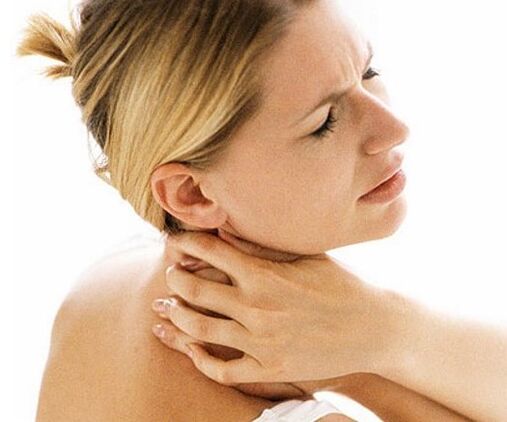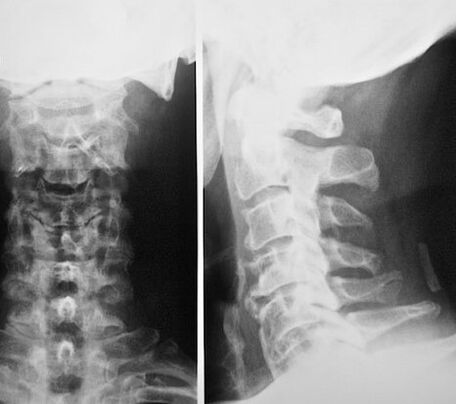Among all the diseases known to mankind are probably the most common diseases of the auxiliary motor. It is unlikely that there are people older than 40 years of age who do not experience spine problems, do not complain of joint pain or muscles. The cause of this phenomenon is most commonly seductive when age, when reducing motor action, salts and other harmful substances are deposited in the joints, which disrupts the functioning of the bone system. It has been generally accepted that auxiliary and motor orata diseases only appear in people of sexual age, but nevertheless, young people often have a diagnosis of this type of disease in recent years. Treating such diseases is quite difficult, especially when degeneratively - dystrophic changes that affect neighboring cartilage, bones and nerve tissues, tissues. The structure of the bone system disrupts the many diseases, a special place for a disease such as cervical osteochondrosis, which is considered to be the most common disease of our time and is found not only in sexual age but also in young people under the age of 35.

Osteochondrosis of the cervical region is a progressive disease, so timely treatment and later seeking a physician - Spina can lead to human disability. What is this insidious disease? What are the symptoms of cervical osteochondrosis and how to deal with this disease?
How does cervical osteochondrosis develop?
Cervical osteochondrosis is a progressive disease characterized by degenerative - dystrophic changes in the intervertebral discs that serve deformations, altering their structure, which causes many pronounced symptoms. At the risk of developing osteochondrosis of the cervical region, people who lead a seductive lifestyle, or whose professional activity is associated with the body for a long time. In terms of osteochondrosis incident, cervical spine injury is second after lumbosacic osteochondrosis. The peculiarity and difficulty of the disease is that damage to the cervical region almost always affects the nerve roots of the spinal nerves and intervertebral discs, resulting in large and small vessels defeated by the blood supply to the brain.
The cervix has a complex structure and consists of 7 spine, each of which performs many functions: supports, returns, pours into the neck and other important functions. Among the vertebrates there are intervertebral discs that make the spine flexible and durable, and the intervertebral discs themselves consist of fibrous rings inside the pulp nuclei. The cervical vertebrates fit close to each other, so even a small physical activity can lead to their movement, which in turn causes the blood vessels and nerves to weaken. In the cervical spine there are spine arteries responsible for blood supply to the brain. When they are compressed, the blood supply breaks, the brain does not receive sufficient amounts of vital substances, which undoubtedly leads to its defeat and the development of many complications, which can lead to patient disability or even death.

The main causes of cervical osteochondrosis
Despite the prevalence of this disease and achieving modern medicine, the pathogenesis of osteochondrosis of the cervical spine has not been fully studied. It is known that the disease can develop in the cervical spine in the wake of metabolic decreased processes, which over time causes a change in the structure of the intervertebral discs and spine organs. Among other types of osteochondrosis, the cervix is the most dangerous, as it is contracted by the nerve roots of the spinal cord and blood vessels during its development, which undoubtedly causes blood supply to the brain cells. In the pathogenesis of the disease, doctors distinguish several provoking factors that can lead to the development of the disease.
- Tempting lifestyle.
- Disruption of metabolic processes in the body.
- Salt deposition in the cervical region.
- Improper or unbalanced diet;
- Long -term delays in the body in one position: working on a computer, driving a car.
In addition to the factors that may lead to the development of cervical osteochondrosis, experts distinguish people who are at risk of developing the disease.
- Genetic predisposition.
- Cervical spine injuries.
- Long -term or periodic hypothermia of the body.
- Hormonal imbalance.
- Chronic diseases of the auxiliary and motor apparatus: rheumatism, scoliosis, systemic lupus erythematosis.
- Excess weight.
Cervical osteochondrosis may be the other causes, but in any case the disease should be treated with its first signs.
How to admit osteochondrosis of the cervical region and what are its signs?
Clinical signs of osteochondrosis of the cervical cervix develop slowly. Symptoms of the disease depend on the quality and quantity of the damaged spine and the nerve endings. The main symptom of the disease is the pain of different intensity of the spine, neck, lower back, which are given to other organs. Only the doctor can diagnose "cervical osteochondrosis" after the results of the examination, as the diversity of the disease clinic often resembles other pathologies, but anyone can be suspected of the disease.
- Pain in the neck that gives the back, ears, forehead part, forearm, chest, support. Painful sensations of varying intensity are improved by minimal load or head alternately.
- Upper and lower extremities, burning, quarreling.
- Headache, dizziness.
- Crash.
- In the eyes darkened, "flying" in front of the eyes.
- With its sharp turn.
- Noise in the ears.
- Language of the language.
- Disruption of coordination.
- Listening reduction, visual gravity.
- Pain in the heart.

Clinical signs of osteochondrosis of the cervical region are expressed and it seems that the disease is developing and progressing. Doctors who are involved in the treatment of this disease distinguish several cervical osteochondrosis syndromes, each of which has its own characteristics and is manifested by the damaged nervous spine.
- Rest syndrome - develops as a result of the first pair of nerve endings of the cervical spine. The patient feels severe pain in the neck, which is given in the shoulder blade, lower back, shoulder and forearm.
- Spinal artery syndrome is characterized by a pulsating headache in the head or in the back of the temporal region. Pain of irritable-refrigerant syndrome in the neck and shore, which extensively occurs when it turns to the head, sleep or cough, gives the chest and support.
- Cardiac syndrome is a whole group of symptoms that initially resembles the symptoms of angina pectar. This syndrome develops in case of damage to the diaphragmic nerve or large chest muscle spine. The main signs are considered heart crushing pain that does not pass after nitroglycerin administration. Such pains can last for several hours, activated during control or deep breathing. In the patient, such symptoms cause panic because they resemble a heart attack.

Symptoms of cervical osteochondrosis
Cervical osteochondrosis - Symptoms and treatment directly depends on the damaged nerve spine. The number of cervical roots is 8, and the cervical spine is 7. Each cervical nerve is above the spine and has its own symptoms.
If the first and second cervical spine (CI-II) is defeated, then the sensitivity of the back will bother, which attracts pain in the parietal and back region.
Damage to the end of the nerve (C3) is very rare, but nevertheless, when it is damaged, the patient feels nausea, in the area where the pinching has occurred. Language speed, tongue sensitivity are also impaired.
C4 damage to the nerve spine causes a collar or shoulder pain and numbness. There are disorders in the respiratory system, heart pain.
If the vertebral 5th sector is bothered by a segment, then the patient will feel the pain that extends to the shoulder, the outer surface of the shoulder, and the sensitivity of the upper and lower extremities is also impaired.
The most common events for the roots of C6 and C7 among patients. Patients feel pain in the neck, knife, forearm, back, lower back, hands, fingers.
When the nerve affects the spine, then the pain spreads throughout the neck, on the back, on the elbow and gives the lower extremities. The small fingers on the arms and legs are marked, the sensitivity of the skin is virtually non -existent. The legs and hands of the hands acquire a tint of tint because of blood circulation.
In addition to pain syndrome, a patient with cervical osteochondrosis also complains of other diseases described above in the signs of the disease: impaired vision, dizziness, discoloration, etc. Sh.
Media physical education for cervical osteochondrosis
Physiotherapy exercises should be performed and performed only after consulting your doctor. In addition, the movement should consider each performance with a specialist, as the wrong position of the neck or limbs can cause even more harm to health and exacerbate treatment. Consider some safe exercises that can be performed for patients with cervical osteochondrosis.
- In a flat surface on a flat surface - Divide your arms on the sides. Take your arms, turn your body slightly to the left, to the right. The left palms of your hand touch your right palm and vice versa. Do such exercises 5 - 6 times.
- In a cheated belly, stretch your arms along the body. Try to relax your muscles and slowly turn your head to the left, then right. It is important to try to touch the floor on the ear. Such an exercise can be performed as in the photo. Perform 8 - 10 times.

- Lying on your stomach, try to rely on the chin in your palm, your neck muscles should be relaxed. Do it 5 times.
- Drink yourself slightly, then gradually lower. Neck muscles resist, so such exercise should be carefully performed. Repeat the exercise 5-6 times.
- You have to get up exactly, straighten your shoulders. Then slowly turn your head to the right, then turn left. So 5 - 6 times.
- Place your fingers on the back of your fingers, place the elbows together, place the forearm chin. Try to increase the reduced forearm as high as possible. Repeat such an exercise 5 - 6 times.
- Take the elbows. With slow movements, lift yourself up and freeze your body down, stretch your arms in front. So 5 - 6 times.
Physical education is quite effective in treating cervical osteochondrosis, but all exercises should be performed regularly and properly. Of course, the situation will not improve from first classes, so you have to be patient.
Treatment of osteochondrosis of the cervical department by folk remedies
Traditional medicine has also shown its efficacy to treat cervical osteochondrosis, which has collected a large number of recipe for hundreds of years in its arsenal for decades, which will help reduce the symptoms of the disease. Treatment of osteochondrosis with folk remedies is the use of vegetables and animal products for external or internal use.
Recipe 1. Honey from cervical osteochondrosis. You will need 1 - 2 teaspoons of natural bee honey, 2 tablets of mummy. Honey and mummy should be heated, put on a warm scarf and attached to the neck at night. Honey has a pronounced antique, biostimulatory properties, so it can perfectly complement the treatment of this disease.
Recipe 2. Celery from osteochondrosis. 4 - 5 grams of celery should pour 1 liter of boiling water, insist for 2 - 4 hours, hold and take 1 large spoon 3 times a day.

Recipe 3. Chamomile and olive oil decoction. You will need 30 grams of chamomile flower, 0, 5 L of olive unproductive oil. Chamomile flowers should be poured into oil, put on a small fire, bring to a boil and cool. You should insist for 2 days, then soak it fully and expand the sick areas with the resulting oil. Chamomile can be used with other herbs: celandine, calendula, st. John's wort. If there is no olive oil at hand, then you can get sunflower.
There are other remedies for traditional medicine that help to relieve symptoms of cervical osteochondrosis. However, it is important to remember that such treatment is effective only at the beginning of the disease and can only be used in traditional methods in difficult treatment.
Prevention
Prevention of neck osteochondrosis is an active lifestyle. In cases where the location of the development of this disease is, it is necessary to periodically visit the doctor - orthopedic. No less important is the food that should be useful, rich in vitamins, minerals and other beneficial substances. Excess weight prevention or adjustment, as well as regular physical exercise, reduces the risk of developing cervical osteochondrosis several times.

















































